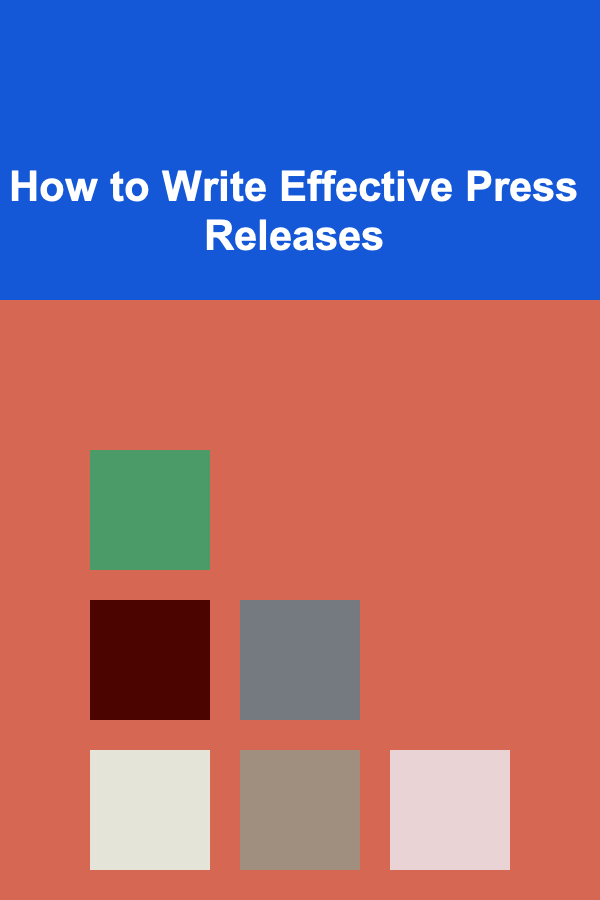
How to Write Effective Press Releases
ebook include PDF & Audio bundle (Micro Guide)
$12.99$7.99
Limited Time Offer! Order within the next:

Press releases are one of the most critical tools in public relations and marketing, serving as the primary method for businesses, organizations, and individuals to communicate newsworthy events and announcements to the media and the public. When written well, a press release can generate significant media coverage, boost brand awareness, and establish an organization's credibility.
In this comprehensive guide, we'll dive into how to write effective press releases that capture attention and get results. We'll cover the essential components of a press release, best practices for crafting compelling content, and tips on formatting and distributing it to ensure maximum exposure.
What is a Press Release?
A press release is a written statement issued to the media with the intent of informing them about a specific event, product launch, corporate update, or other newsworthy developments. Unlike general marketing content, press releases are typically more objective and fact-based, written in a formal journalistic style, and designed to provide journalists and media outlets with all the relevant information needed to write a story.
Press releases are often used to announce:
- New product launches
- Corporate mergers or acquisitions
- Leadership changes
- Event announcements
- Crisis management or corporate responses to negative situations
- Awards and recognitions
- Research findings or industry reports
When done right, press releases can grab the attention of journalists, influencers, and readers, driving visibility for your brand.
Key Elements of an Effective Press Release
To write an effective press release, you need to ensure it includes specific key components that journalists are accustomed to seeing. These elements also help make your press release more effective by making it easy to read, scan, and understand.
1. Headline
The headline is arguably the most important part of your press release. It's the first thing journalists will see, and it needs to grab their attention. A good headline should be concise, informative, and compelling. It should clearly convey the essence of your news, while creating intrigue.
- Example: "XYZ Corp Launches Revolutionary Smartphone That Lasts 3 Days on a Single Charge"
Keep the headline under 70 characters, as longer headlines may be truncated when shared on social media or in email newsletters. Use active voice, and avoid using overly technical jargon or complex language that could confuse your audience.
2. Subheadline
While the headline grabs attention, the subheadline should provide more detail about the news. It acts as a secondary, supportive line of text that offers a clearer understanding of the subject of the press release.
- Example: "The innovative new model aims to redefine the smartphone experience by offering unmatched battery life."
Think of the subheadline as an extension of the headline, providing additional information that encourages readers to continue reading the full press release.
3. Dateline
The dateline includes the location where the press release is being issued from and the date it is being released. It's essential because it helps establish the context of the news and allows journalists to know the time-sensitive nature of the announcement.
- Example: "San Francisco, CA -- May 29, 2025"
The dateline should be placed at the very beginning of the first paragraph and set in bold.
4. Introduction (Lead Paragraph)
The first paragraph is crucial because it offers the most vital details in a concise format. The lead paragraph should answer the essential questions: Who, What, Where, When, Why, and How. It should provide the journalist with enough information to understand the main news of the release.
What to include:
- The main point of the press release
- Key facts that provide context
- The most important event or announcement
- Contact information for follow-up queries
Example: "XYZ Corp, a leading tech company based in San Francisco, today announced the launch of its latest product: the XPhone Pro, a smartphone that can last up to three days on a single charge, setting a new standard for battery longevity in the mobile industry."
5. Body Paragraphs
The body of the press release provides further details and context, often expanding upon the lead. This section includes quotes from key individuals involved, such as executives or subject matter experts, as well as data, statistics, and additional background information.
Each paragraph should build upon the last, with the most important information at the top and the least critical details toward the bottom. Use clear, easy-to-understand language, and break up large blocks of text to make the press release more readable.
In most cases, the body paragraphs will include:
- Quotes from a company spokesperson, such as a CEO or product manager
- Additional details on the product, event, or initiative
- Background information about the organization or industry
- Statistical data to support claims made in the release
6. Quotes
Including quotes in a press release adds authority and personal touch. Quotes from credible sources can help validate the significance of the announcement and provide the press with useful soundbites for their stories.
For example: "'Our team has worked tirelessly to create a smartphone that delivers exceptional battery life without sacrificing performance or design,' said John Doe, CEO of XYZ Corp."
Ensure that the quotes are relevant and add value to the press release. Avoid making the quotes too promotional; instead, use them to provide insight into the thinking behind the announcement.
7. Call to Action (CTA)
A press release often concludes with a clear call to action (CTA). A CTA is a prompt telling readers what they should do next, whether it's visiting a website, downloading a product, or contacting the company for more information.
Example: "To learn more about the XPhone Pro and pre-order, visit www.xyzcorp.com/xphonepro."
Keep the CTA direct and easy to follow. Avoid making it overly sales-focused, as the goal of a press release is to inform, not directly sell.
8. Boilerplate
The boilerplate is a short paragraph at the end of the press release that provides background information about the organization issuing the press release. It's a standard section that doesn't change from release to release, but it helps journalists quickly understand the organization's history, mission, and values.
Example: "XYZ Corp is a leading innovator in consumer technology, known for its commitment to developing groundbreaking products that enhance the everyday lives of users. Founded in 2010, XYZ Corp has been recognized for its pioneering work in smartphone technology and sustainable design."
9. Media Contact Information
Lastly, the press release should end with the media contact information. This section allows journalists to reach out for further clarification or interviews. Include the contact person's name, title, email address, and phone number.
Example: "Media Contact: Jane Smith Public Relations Manager XYZ Corp Phone: (123) 456-7890 Email: [email protected]"
Writing Style and Tone for Press Releases
While a press release is a formal document, the tone and style you choose can vary depending on the nature of your announcement. However, regardless of the type of news you're sharing, your press release should:
- Be factual and objective: Avoid overly promotional language, and stick to the facts.
- Use the inverted pyramid structure: Present the most important information at the top and work your way down to less critical details.
- Be clear and concise: Keep your language simple and to the point. Journalists are busy, so they should be able to quickly understand your key message.
- Avoid jargon: Unless it's a highly technical press release targeting experts, try to minimize industry-specific terminology or explain it if you must use it.
- Be neutral: Focus on the news, not your opinion. The goal is to provide information, not to persuade.
Press Release Distribution: Best Practices
Once you've written your press release, the next step is distribution. Writing an effective press release is just the first part; you need to get it in front of the right people to maximize its impact.
1. Targeted Media Outlets
Make sure to send your press release to the right journalists, editors, and publications. Research the outlets that cover the topics relevant to your news. If you're launching a new tech product, for example, target tech journalists and websites. If you're making a corporate announcement, send it to business and industry-specific media.
2. Press Release Distribution Services
If you want your press release to reach a broader audience, consider using a press release distribution service like PR Newswire or Business Wire. These platforms allow you to distribute your release to thousands of journalists and media outlets, increasing the likelihood of gaining media coverage.
3. Personalized Pitches
While distribution services are valuable, it's important to take the extra step of personally reaching out to key journalists with a tailored pitch. Customize your message to show why the press release is relevant to their audience and how it aligns with their current reporting.
4. Social Media
Don't overlook social media in your distribution strategy. Sharing your press release on your company's social media platforms can amplify its reach, especially if your followers engage with and share it. You can also tag relevant journalists or publications, increasing the chance of media coverage.
5. Follow-Up
After distributing your press release, follow up with key media contacts to ensure they received it and to see if they have any questions. Don't be overly pushy, but be polite and professional when asking if they're interested in covering your story.
Conclusion
Writing an effective press release requires a strategic approach. By focusing on clear, concise writing, providing the right amount of detail, and following a structured format, you can significantly increase the chances of your release being picked up by journalists and media outlets. Don't forget that timing, distribution, and follow-up are just as important as the content itself when it comes to achieving maximum impact. With practice and attention to detail, you can master the art of writing press releases that generate buzz and promote your organization effectively.

How to Create a Holiday Mood with Soft Lighting and Fabrics
Read More
How to Create a Mobile Workout Station with Carts
Read More
How to Renovate Your Bathroom with a Small Budget
Read More
How to Use Deep Learning to Build a Scalable Passive Income Business
Read More
How to Use Live Streaming Platforms to Make Money
Read More
Unlocking Excellence as a Dental Hygienist: A Comprehensive Guide to Best Practices
Read MoreOther Products

How to Create a Holiday Mood with Soft Lighting and Fabrics
Read More
How to Create a Mobile Workout Station with Carts
Read More
How to Renovate Your Bathroom with a Small Budget
Read More
How to Use Deep Learning to Build a Scalable Passive Income Business
Read More
How to Use Live Streaming Platforms to Make Money
Read More